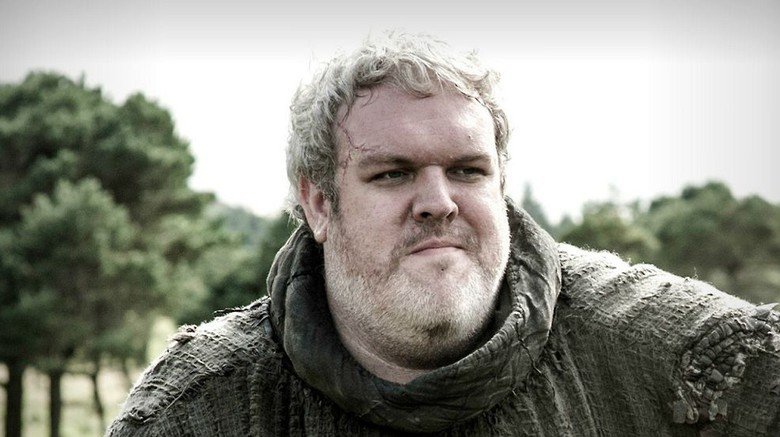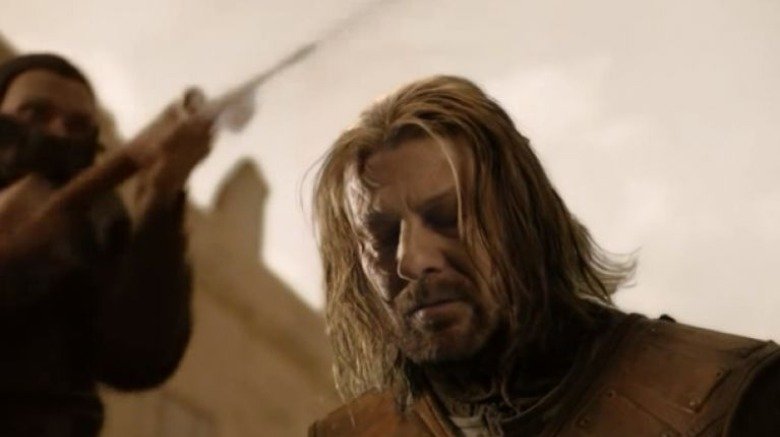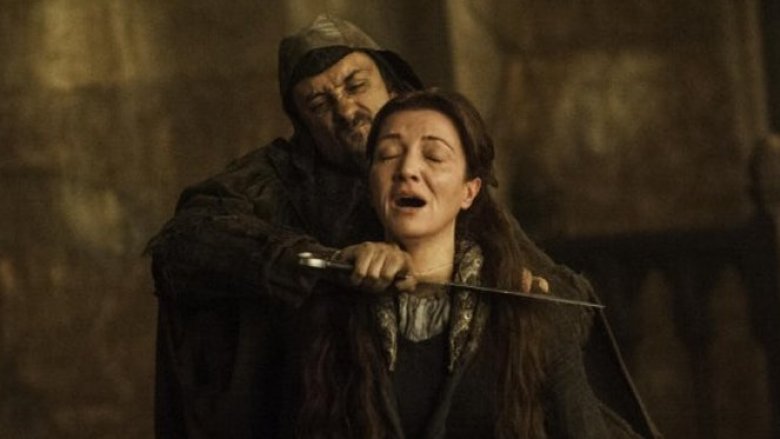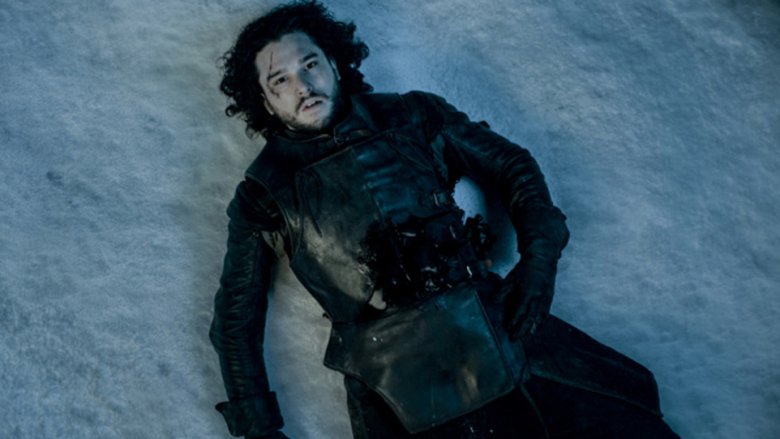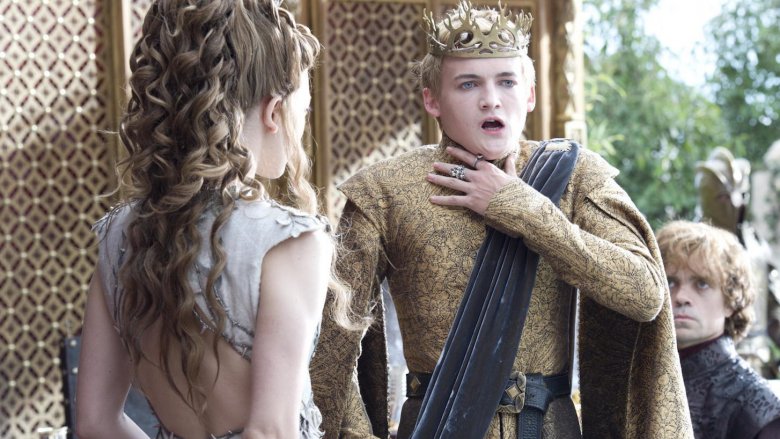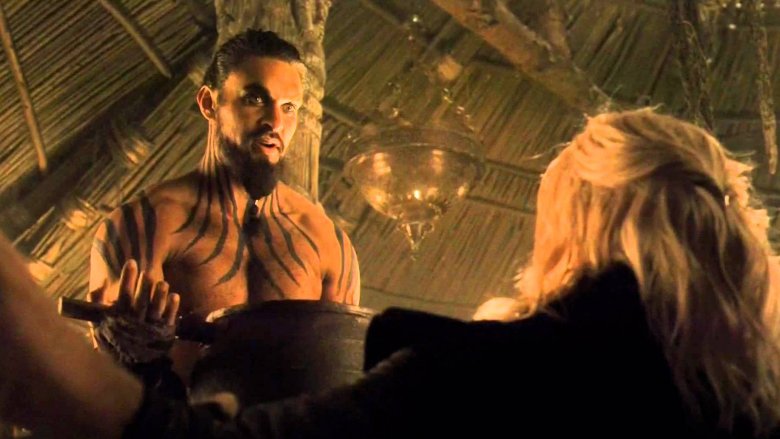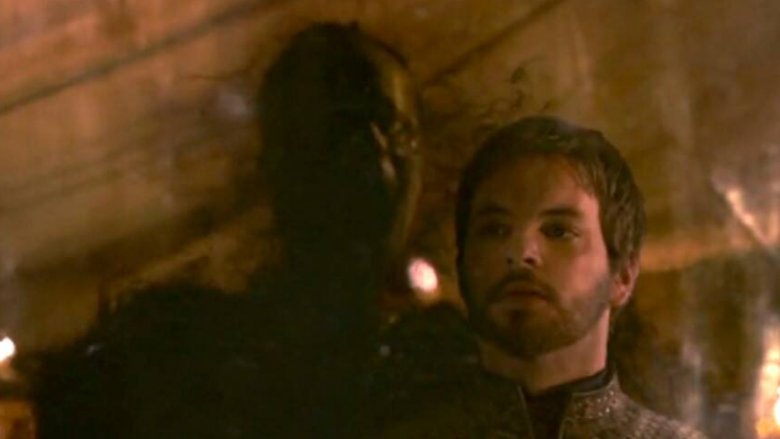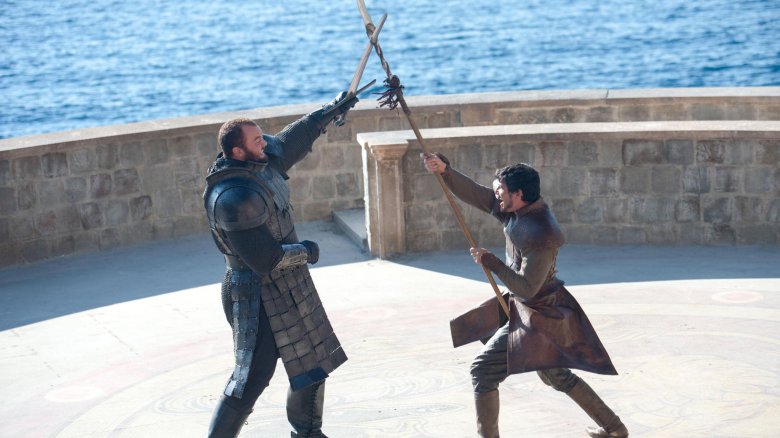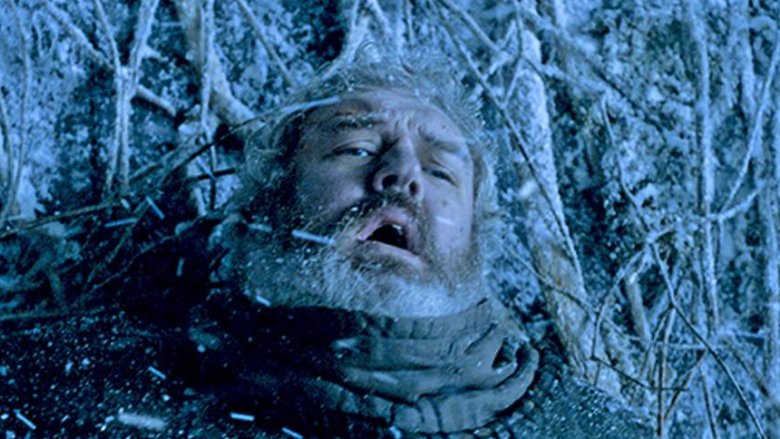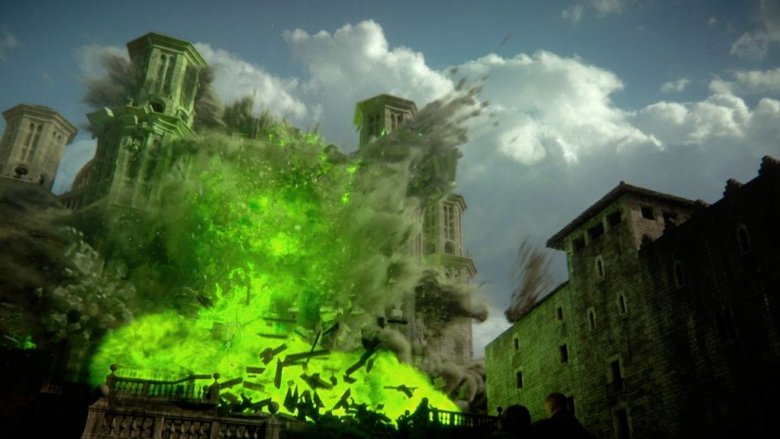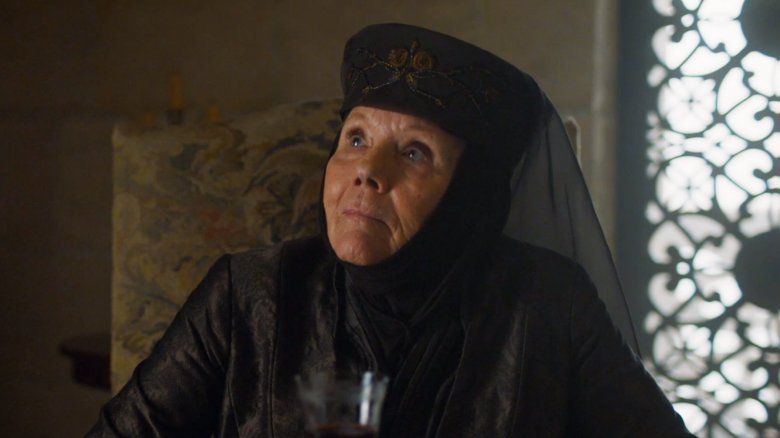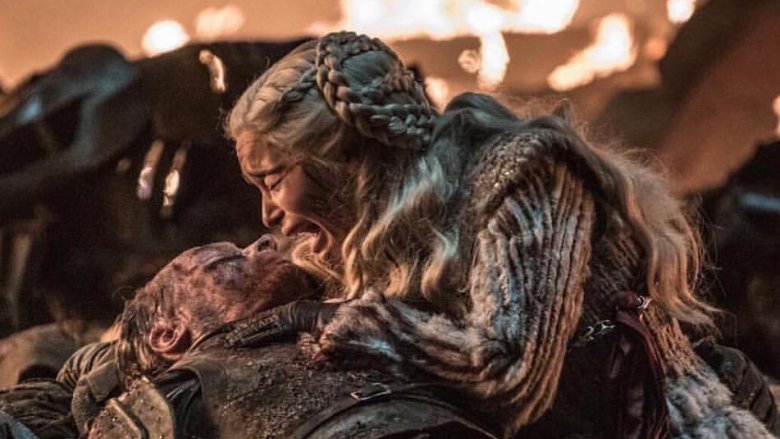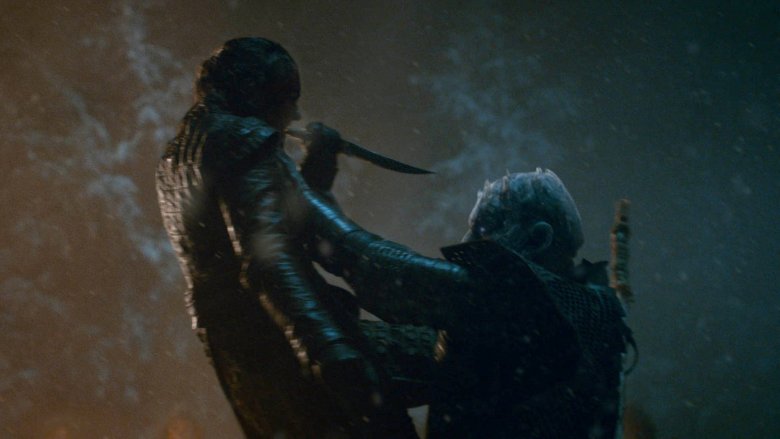The Most Epic Deaths On Game Of Thrones
As you may have noticed, Game of Thrones is quite fond of killing its characters. This is a show where no one is truly safe, and kings, heroes, villains, and peasants alike have met their ends in varying, often gruesome ways. Some of these deaths are tragic, others are outright pathetic, while others still are so fast and forgettable that you'll easily miss them if you blink.
However, every once in a while, a character gets a sendoff that is truly magnificent. Whether it's because of their own heroic actions, the visual majesty of their death scene, or merely the magnificent or heartbreaking circumstances that led to their demise, these characters meet their ultimate fates in ways that are at least as memorable as their actual tenure in the show. Whether you were shocked by them, or saddened by them, or even punched the air and loudly screamed "Finally!" when they happened, these are some of the most epic deaths on Game of Thrones.
(In case you know nothing, you should at least know that this article will contain spoilers for Game of Thrones.)
Ned Stark's execution changes the game
Throughout its first season, Game of Thrones had given us warnings that it might not be the most traditional fantasy show. Then came the ninth episode, "Baelor," and the show threw the rulebook out the window. As the AV Club notes, Eddard "Ned" Stark was a very traditional, noble fantasy hero played by Sean Bean, then the most famous name in the cast. His quest was a fairly traditional one, too: He was the honest man entering a snakepit of plotting politicians and dubious knights, serving as the Hand of the King and trying to find out who killed his predecessor. He was powerful. He was honest. Even when his king died, when political pressure mounted against him, and when the new, unhinged King Joffrey sentenced him to death, everyone thought his plot armor was impenetrable. Even when he knelt down and executioner Ser Ilyn Payne readied his sword, we expected a last-minute swashbuckling rescue or a change of heart by his captors. He was the hero. Of course he couldn't die.
And then, just like that, they cut his head off. In one fell swoop, the Starks (and the viewers) found out that heroes had no chance of winning the game of thrones just by playing nice, and all bets were off.
The Red Wedding shocks everyone
George R.R. Martin has called the Red Wedding the most powerful scene he ever wrote. In Game of Thrones, it's arguably worse than in the books, and it remains effective even after repeated viewings.
Sure, we knew that Robb Stark, the King in the North at the time, was in at least some hot water with Walder Frey for breaking his promise to marry a Frey girl and throwing his uncle Lord Edmure Tully at the altar instead, especially as Robb was attending what should have been his own wedding with his new, pregnant wife, Talisa. We had every reason to believe that something would happen. It's just that when things started unfolding, they never stopped for the rest of the episode. The Lannister song "Rains of Castamere" started playing. Catelyn Stark realized that their supposed ally Roose Bolton was wearing armor underneath his fancy clothes. The pregnant Talisa Stark got repeatedly stabbed in the stomach. Everyone died and kept dying. Robb Stark got pierced by arrows, desperately calling for her mother, and finally got finished by Bolton, complete with the Lannisters' regards. Robb's direwolf got killed. Everyone died.
The episode's final image is perhaps its most tragic one: After one final failed gambit stop it all, Catelyn realizes that everything is lost, lets out a desperate wail, kills her hostage, and just sits there in disbelief until her throat is slit. Then ... cut to black. Nothing. Enjoy the rest of your evening, viewers!
Jon Snow is betrayed by his brothers
Beric Dondarrion might hold the record for most resurrections in Game of Thrones, but he's not the only character who has died and returned as a more or less normal guy. Back in Season 5, Jon Snow's radical ideas about enlisting the Wildlings to help deal with the true enemy made the rest of the Night's Watch pretty uncomfortable with their new Lord Commander, which resulted in a Julius Caesar-style stab-fest where several of Jon's comrades escorted a knife into his gut. It was brutal and unexpected, and the dramatic visual of a lifeless Jon lying on the ground made a pretty tense season-ending cliffhanger.
However, as Polygon notes, Jon Snow's rebirth in Season 6 lost some of its impact because it was telegraphed a mile away. After all, it had already been established that the Lord of Light could grant the power to raise the dead, and Melisandre, a noted and powerful priestess of said god, was conveniently hanging out in Castle Black when Jon died. In the end, Jon Snow shrugged off death with nothing but a fresh, new hairstyle and some pretty impressive scars.
King Joffrey drinks his last cup of wine
Joffrey Baratheon was the ultimate rich kid who could do anything without consequences. Officially the heir to the Iron Throne, secretly a product of an incestuous relationship between Jaime and Cersei Lannister, and openly a vain sadist, his parentage meant he had plenty of Lannister support behind the scenes and was free to indulge in his Emperor Nero-style antics when he rose to the throne. He was one of the show's most hated characters, so his death was eagerly anticipated. As the Independent reports, fans finally got their wish in the second episode of Season 4 when an unknown assassin poisoned King Joffrey during his own wedding and the young royal collapsed on the ground, his face swollen and eyes bleeding. In an interview with Entertainment Weekly, George R. R. Martin has said that this welcome yet unexpected death was always his plan for Joffrey, and his "Purple Wedding" demise was an intentional counterweight to the bloody Red Wedding, intended to show that absolutely no character is safe.
Although Joffrey himself spent his last bit of strength blaming his hated uncle, Tyrion Lannister, the person behind the poisoning was later revealed to be Lady Olenna Tyrell, who used this information to deliver a final gut punch to the Lannisters before her own death.
Viserys Targaryen gets his golden crown
Viserys Targaryen was an arrogant and ruthless hatebucket who liked to call himself a dragon and sold his sister Daenerys to the scariest warlord he could find, Khal Drogo of the Dothraki. While this jump-started Daenerys' road to greatness, Viserys only had his own best interests at heart, as Drogo agreed to help him conquer the Seven Kingdoms in return. During a feast at Vaes Dothrak, a drunk Viserys decided he had enough of waiting and demanded Drogo deliver on his martial promises. Otherwise he would walk back on their deal, take back Daenerys, and kill their unborn child. This was not a smart move.
Viserys failed to read the room even when Drogo ominously promised to deliver the "golden crown" he so desired. The young man spent his last moments in terror and agony as Drogo poured molten gold over his head in a grisly scene that gave us one of our first tastes of the show's trademark carnage. (Actor Harry Lloyd told Entertainment Weekly the effect was achieved with a combination of custom skull caps, gold-colored gelatin, and a hidden smoke machine.) Daenerys took this development in stride and merely commented: "He was no dragon. Fire cannot kill a dragon."
Cruel as this Season 1 death was, it could have been even worse: Science Alert says our own, real-life history includes people who were executed by having gold poured down their throats, which essentially steamed their insides to death.
Renly Baratheon meets the shadow monster
The vast majority of deaths in Game of Thrones come from blatant physical violence. Renly Baratheon's death in Season 2, however, was something completely different. Renly was a brother of the late Robert Baratheon, and a participant in the War of the Five Kings. Sadly for him, another one of said kings was his brother Stannis, who was far more ruthless and had some rather unconventional weapons at his disposal. A failed meeting between the two brothers led Stannis to assassinate Renly with perhaps the strangest method the series has seen: a living shadow monster that Melisandre the Red Priestess birthed after getting intimate with Stannis.
The "shadow baby" materialized behind Renly in his tent and stabbed him to death with his talon before disappearing, leaving Renly's bodyguard Brienne of Tarth looking super-guilty, all alone in a tent with the corpse of a freshly stabbed king. Brienne managed to escape and eventually got to kill Stannis in retaliation.
The Mountain faces the Viper
Prince Oberyn "Red Viper of Dorne" Martell was perhaps the closest thing to a hero King's Landing had seen since the death of Ned Stark. The Dornish prince arrived in King's Landing to shake things up in Season 4, and while he loved fun and had charisma to spare, he also had an agenda of his own: He hated the Lannisters with the fullness of his heart, and sought revenge on Lannister bannerman Gregor "The Mountain" Clegane for brutally assaulting his sister and killing her and her children. As such, when Tyrion Lannister sought a representative for his trial by combat and Oberyn found out the Mountain was fighting for the other side, he promptly volunteered.
The duel between Oberyn and the Mountain was brutal, but Oberyn eventually gained the upper hand and managed to severely wound the Mountain. Unfortunately, in his furious attempts to make the giant confess his crimes against the Martells, he ventured too close to the fallen giant. In a scene straight out of a horror movie, the Mountain swept Oberyn to the ground, punched his teeth out ... and graphically gouges out the Viper's eyes before crushing his skull with his bare hands. Ouch. Ick.
Hodor
In a show full of clever characters, articulate speeches, violence and duplicitous actions, Hodor stuck out like a sore thumb. Bran Stark's lovable, hulking traveling companion was a genuinely gentle soul who could only speak what we thought was his name, and as a solid fan favorite with little purpose in the larger plot, he was almost guaranteed to die somewhere along the line.
Hodor's eventual demise was undeniably epic, but also far more tragic than any of us could have guessed. As Esquire describes, Episode 5 of Season 6 revealed Hodor's backstory when White Walkers and wights attacked the tree of the Three-Eyed Raven. During the onslaught, Bran's body was present, but his mind was in the past, watching his father and young Hodor. When the present Hodor was told to "hold the door" to keep the dead at bay so the party could escape, the events bled into the mind of past Hodor through Bran. Until that very moment, he was a perfectly ordinary boy called Wylis, but the mental shock of seeing and hearing the final moments of his adult self across time broke his mind and caused him to repeat the phrase "hold the door" faster and faster until it twisted into "Hodor." This turned him to a broken man, going through life as a shadow of his former self so he could eventually sacrifice his life to save his friends. It's entirely possible that Hodor's last moments have never been observed by dry eyes.
The Sept of Baelor explodes
By the Season 6 finale, King's Landing was in upheaval. The High Sparrow and his Faith Militant were in control, and prominent characters faced trials for assorted crimes in the eyes of the gods. With the city's most cunning political animals either absent or powerless, it appeared no earthly power could stand against the power of the Seven. No earthly power, that is, except for Cersei Lannister.
Instead of entering the Sept of Baelor for her back-to-back trials with Ser Loras Tyrell, Cersei went on offense. With the aid of Maester Qyburn, she used the explosive wildfire to set a trap for everyone in the Sept. The only person inside the building to be suspicious about Cersei's absence was Margaery Tyrell, but her attempts to evacuate the Sept fell on deaf ears, as the High Sparrow insisted everything was fine ... just before he and everything around him disintegrated in a ball of bright, green flame.
The giant explosion consumed everyone inside the Sept. It severely weakened the Tyrell family (Margaery, Loras, and Mace Tyrell all died), annihilated the Faith Militant, and left Cersei in an unquestionable position of power within King's Landing. The events before and after the explosion also killed Grand Maester Pycelle and Sparrow faithful Lancel Lannister (dispatched by Qyburn and his child spies) ... and unfortunately for Cersei, it also cost the life of her son Tommen, who threw himself out a window after seeing the blast.
Olenna Tyrell gets the last laugh
Lady Olenna Tyrell was known as the Queen of Thorns, but even her fearsome wit was unable to save her after Cersei Lannister killed her family and sent Jaime Lannister to raid Highgarden, the seat of House Tyrell. Luckily for Olenna, Jaime was much less sadistic than his sister and offered her an easy way out with a goblet of painless poison. Less luckily for Jaime, this put Olenna in her comfort zone. She gulped down the poison and, knowing she couldn't be harmed any further, used her last moments to unleash a truly epic barrage of truth bombs.
With just a few sentences, Olenna dropped expert hits on the late King Joffrey ("He really was a c*nt, wasn't he?"), Cersei ("Your sister has done things I wasn't capable of imagining."), and Jaime himself ("She's a monster, you do know that? You love her, you really do love her. She'll be the end of you."). Finally, she compared Joffrey's extremely brutal and painful death by poison to her own, easy painless one — and almost casually admitted to Jaime that she was the one who killed his and Cersei's incestuous king-son. She finished her all-out attack with a final mic drop: "Tell Cersei. I want her to know it was me." With that, Olenna Tyrell peaced out, having verbally and emotionally destroyed her opponents one last time.
Jorah Mormont saves his Queen again and again
Ser Jorah Mormont's fate is intertwined with Daenerys Targaryen's. First he spied on her for Robert Baratheon, then fell for her and became her loyal adviser. After Daenerys found out and exiled him, he fought himself back in her favor. He faced enemy hordes, conquered a fatal illness, and even learned to step back in favor of wiser and better men, all so he could best protect his queen.
When wights overwhelmed Daenerys' dragon steed during the Battle of Winterfell, she was left on the ground, helpless against the hordes of approaching undead. Out of nowhere, Ser Jorah leapt to the rescue, and single-handedly mowed down dozens of enemies. The knight sustained numerous wounds during the battle, but despite his increasing anguish, didn't allow himself to fall until it was clear that Daenerys was safe. Much like his life, his final moments were not easy. Ser Jorah was hurting too much for fancy final speeches or confessions, so he died as he lived: doing what he did best, without much fanfare. He still got to die by his beloved Khaleesi, though, so at least there's that.
Actor Iain Glen's wife suffered a brain hemorrhage during the shooting of Ser Jorah's last stand, which he said turned him into "a total mess." This might have bled through to the way he portrayed Jorah's terrible pain in the scene.
The killing of the Night King
The White Walkers have been a threat to Westeros since the beginning of the show, and as their creator, the Night King has been set up as the show's Big Bad for years. That's why it was so surprising when the seemingly invincible villain was destroyed during the Battle of Winterfell, especially as Jon Snow and Daenerys Targaryen had already fought him to no avail: First, their dragons fought the Night King's ice dragon, and the King survived a long fall to the ground. After that, Daenerys attempted to kill him with dragonfire, which had absolutely no effect. After that, Jon tried to duel with him, but the Night King countered with a wall of freshly resurrected wights.
With the two heroes sidelined, the Night King was free to advance toward his primary target, Bran "Three-Eyed Raven" Stark. Theon Greyjoy ran to what he knew would be his death, and all hope seemed to be lost when suddenly Arya Stark jumped the Night King from the shadows. He managed to catch her by the throat and wrist, but Arya deftly dropped her Valyrian steel dagger into her free hand and stabbed him in the gut. This caused a chain reaction that took down the entire army of the dead.
According to the Verge, Game of Thrones showrunners have known for years Arya would eventually take down the Night King, and have sprinkled visual hints of this scene in multiple episodes. For instance, Arya debuted the hand-swapping move in Season 7, during her sparring match with Brienne of Tarth.
